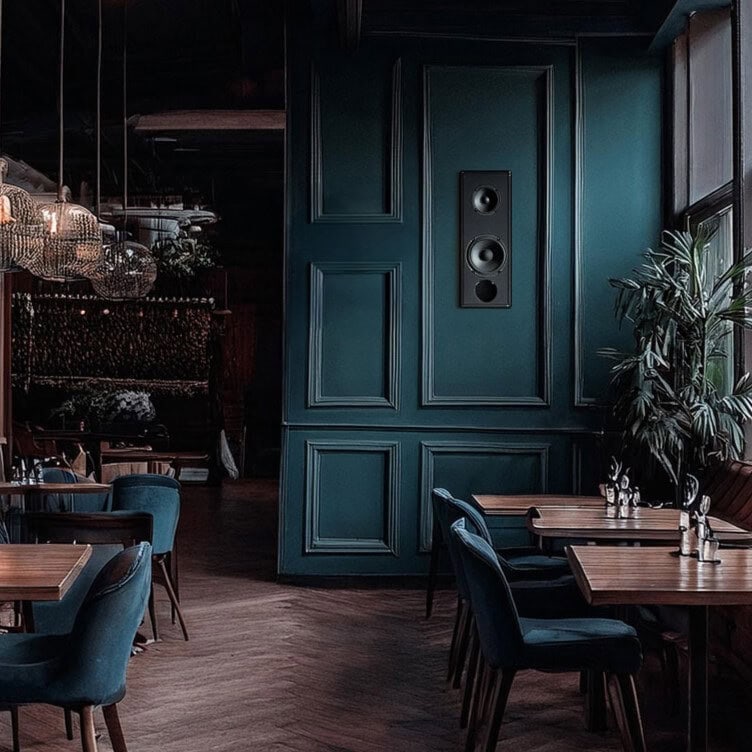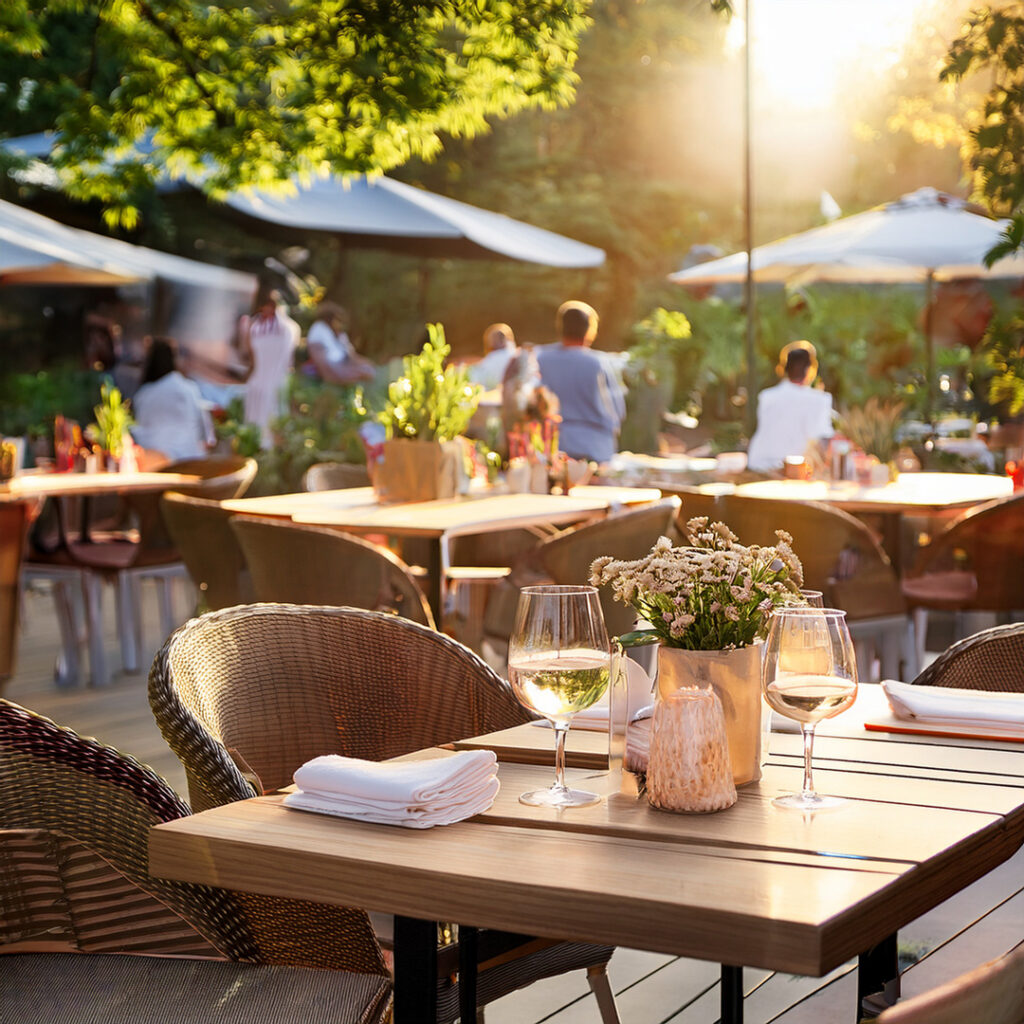The Key Ingredient for an Unforgettable Dining Experience
As a restaurant owner or manager, you’ve carefully crafted a menu, décor, and service experience that make your dining environment memorable. But are you maximizing the power of music in your space? A well-curated restaurant playlist does more than add ambiance; it can influence guest behavior, elevate your brand, and improve customer satisfaction. Let’s explore why music matters, what research shows about finding the best music for your restaurant, and how the right playlist can create an unforgettable experience.
The Science of Music in Restaurants: Tempo, Genre, and Volume
Research shows that music influences more than we realize, impacting guest behavior, perception, and even spending. Here’s how music’s tempo, genre, and volume play a role in shaping a restaurant’s vibe.
Tempo: Setting the Right Pace for Your Space
The tempo of your restaurant’s music significantly impacts customer behavior. In a study comparing slow-tempo (60 bpm) and fast-tempo (108 bpm) music, guests listening to slower tunes spent an average of 11 minutes longer at their tables. For fine dining or wine bars, this translates into higher check averages as guests linger and savor the experience.
To create the perfect tempo-based playlist, consider both classic and unique genres:
- Slow-tempo genres: Bossa nova, ambient jazz, and indie folk encourage relaxation. For a unique touch, try including downtempo electronica or soothing world music to keep guests comfortable and engaged.
- Fast-tempo genres: Latin pop, upbeat indie rock, and energizing folk work well for high-traffic spots, helping increase table turnover while keeping energy levels up.
By carefully selecting tempo-driven music that aligns with your concept, you’re setting a pace that enhances the guest experience and aligns with your business goals.
Choosing the Right Music for Your Restaurant: Why Genre Matters
The music you choose in your restaurant affects how customers see your brand. Studies show that genres like classical and jazz can make a space feel more high-end, encouraging people to spend more on premium items. For instance, one study found that wine store customers spent more on pricier bottles when classical music played instead of Top 40 hits. This shows that the right music can set a tone that fits your brand and influences what customers choose to buy.
But it’s important to know that not every customer group responds to classical or jazz the same way. For younger crowds or more casual spots, these genres might feel too fancy or even out of place. In one study, stores that played family-friendly music saw more purchases and return visits. Music preferences can also change across cultures. For example, the idea that classical music feels “sophisticated” isn’t universal—it depends on where you are and who’s listening.
Music can also help make a restaurant feel more authentic. A 2020 study found that customers thought a restaurant was more “real” and enjoyable when the music matched the cuisine, like Spanish music in a tapas bar. And if too many places in one area start using classical or jazz, it loses its impact, creating a similar environment across multiple venues. Sometimes, too, classical and jazz may not create the right energy for a lively diner or family-friendly restaurant. Different genres work better at different times of day too—what feels right for dinner might not work as well for a busy brunch or lunch crowd.
Here’s a look at which genres can work best for different types of restaurants:
- For a high-end, elegant scene: Classical, jazz, soft instrumental music (like piano or acoustic guitar), neo-classical, or minimalist ambient adds a unique sense of luxury and sophistication.
- For a casual, laid-back feel: Folk, acoustic indie, lo-fi hip-hop, or even reggae create a more approachable, cozy atmosphere.
This effect is often called “auditory symbolism.” In other words, music sends signals about the experience customers can expect. Picking the right genre that fits your brand and concept helps guests connect to your space and the atmosphere you want to create.
Volume: Creating Balance
Volume is a subtle but powerful factor in restaurant ambiance. For many diners, overly loud background music can feel overwhelming, while softer music encourages a sense of comfort. In a study on volume’s impact in retail, consumers spent significantly less time in stores with loud music than those with softer tunes. The same logic applies to restaurants: moderate volumes invite guests to linger, potentially leading to increased spending.
Volume adjustments for various settings can support your restaurant’s goals:
- Louder settings: In sports bars or lively diners, louder volumes can create the energy you want for high-traffic, fast-paced settings.
- Moderate to soft volumes: For upscale restaurants or cafes, a moderate volume enhances comfort, allowing guests to relax and enjoy a more intimate setting.
By setting volume levels that suit your concept, you’ll be able to create an inviting space that encourages longer stays and repeat visits.
Why Curating the Right Music is a Strategic Business Decision
A well-curated playlist does more than add to the atmosphere; it’s a business strategy that drives customer loyalty, brand differentiation, and even employee satisfaction.
Enhanced Customer Experience
Studies show that music influences mood and comfort, directly affecting how guests perceive and enjoy their dining experience. A carefully curated playlist can make guests feel at ease and increase their likelihood of returning. In fact, 67% of guests who took a recent survey, consider themselves regulars at restaurants they enjoy, largely influenced by the music.
Brand Differentiation
Your restaurant’s unique character is essential to its brand identity, and music can amplify that uniqueness. A trendy bistro with a blend of indie rock and jazz attracts a younger crowd, while classical or ambient music can enhance a refined wine bar’s experience. By tailoring music to your target demographic, you’re setting your restaurant apart.
Improved Employee Satisfaction
Music impacts your team’s mood, too. Playlists that align with your restaurant’s pace can keep employees energized and focused, which translates to better customer service. Matching music to your desired floor pace also ensures a more harmonious work environment.
Examples of Successful Music Strategies in the Restaurant Industry
Leading brands have successfully leveraged music to create a branded experience that resonates with customers. Here are a few examples:
- Starbucks’ Curated Playlists: Starbucks uses indie and alternative music to set a calm, city-inspired atmosphere. Through their app, customers can even influence in-store playlists, which enhances customer engagement and builds brand loyalty.
- Chipotle’s Spotify Partnership: Chipotle’s curated playlists on Spotify reflect their casual, upbeat brand, reinforcing their identity and keeping customers engaged during their dining experience.
Mod Wine Co.’s Restaurant Audits and Custom Solutions: Nat worked with a wine bar and designed a playlist that mixed upbeat electronic and indie tracks, creating a cool, modern atmosphere that customers loved. The songs had an average tempo of 115 bpm, striking just the right balance: lively enough to keep energy up but relaxed enough to encourage guests to stay awhile. The playlist was engaging without being distracting.
The results were clear. Customers reported higher satisfaction, stayed longer, and some even subscribed to the playlist so they could enjoy the music at home. Sales also increased as the welcoming atmosphere led people to order more and return more often. This project shows how customized music strategies can make a big impact, helping restaurants create the perfect environment to boost customer loyalty and sales.
Matching Music to Concept: Reinforcing Brand Identity
Music that aligns with a restaurant’s theme and cuisine enhances the customer experience by creating a sense of authenticity. A 2020 study showed that guests at culturally themed restaurants felt greater satisfaction and saw the restaurant as more ‘authentic’ when the music matched the cuisine (e.g., Spanish music in a tapas bar).
By creating a playlist that complements your theme, you’re setting the stage for an experience that aligns with your brand. Restaurant chains like Chipotle and Starbucks understand this well, leveraging playlists that both reflect and reinforce their brand. For independent restaurants, matching music to concept can deepen customer engagement and create memorable dining moments.
How to Create the Best Music for Restaurants
Here are key tips to create a playlist that enhances customer experience and brand identity:
Match the Music to the Mood
Consider your restaurant’s concept, peak hours, and target demographic. For instance, lo-fi beats or acoustic indie can add a modern, relaxed feel to a wine bar, signaling sophistication without feeling stuffy. Meanwhile, neo-soul or contemporary folk might resonate well in a casual café, creating a warm, approachable atmosphere.
Adjust Tempo and Volume Throughout the Day
Softer, slower music for early afternoons sets a relaxing tone, while increasing the tempo and volume during dinner hours can energize the environment.
Keep Your Playlist Fresh
Regularly update your playlist to stay relevant and appeal to regulars. New songs within your genre help keep the experience fresh and engaging for returning guests.
Use Licensed Music Services
Licensed playlists ensure legal compliance, avoiding potential issues and supporting artists. Services like Spotify for Business or Pandora for Business are convenient options.
We Can Help You Perfect Your Playlist!
Curating the Best Music for Restaurants requires a nuanced approach, and we can help. Our restaurant audits, insight reports, and consulting services analyze your unique environment and tailor recommendations to create an ideal ambiance. From custom playlists to optimizing your atmosphere, we offer guidance that enhances your guests’ experience and aligns with your brand identity.
Ready to bring new energy to your restaurant’s space? Reach out to us to schedule a consultation or explore our Spotify account for expertly curated playlists tailored to restaurant settings.



